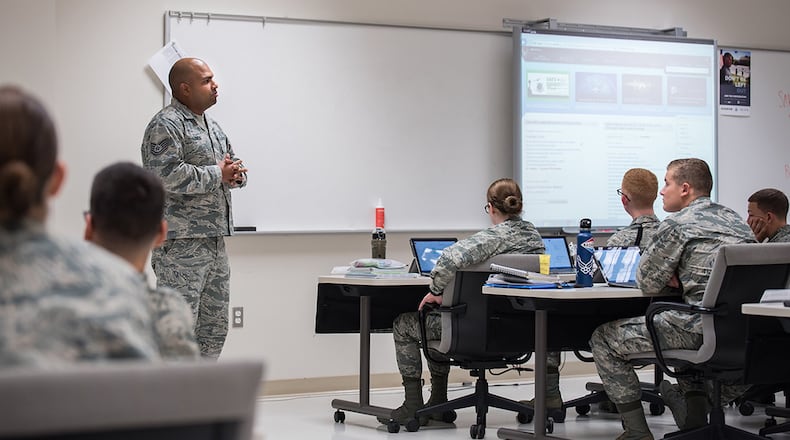What makes USAFSAM a prominent institution for aerospace medicine are the dedicated instructors, who prepare the medical force to face future readiness challenges.
From combat to the non-traditional classroom
Operational experience is part of what makes USAFSAM instructors uniquely qualified to get medical Airmen mission ready, according to Staff Sgt. William Ensrud, assistant course director for aerospace and operational physiology apprentice course.
“Our medical expertise branches outside of the traditional hospital or clinic,” said Ensrud. “Our instructors have been overseas taking care of patients, collecting data, doing evaluations and keeping service members healthy. USAFSAM instructors have a breadth of experience that is far beyond what people may expect.”
Ensrud arrived to USAFSAM in 2017 with more than five years of experience training new aircrew members on the physiological components of flight, such as how to overcome fatigue and stress, and how to take care of themselves in the event of an ejection.
This type of operational background helps instructors make simulations and scenarios realistic, taking advantage of the resources at Wright-Patterson Air Force Base.
“In a real mission, critical care air transport teams can’t go anywhere without aeromedical evacuation crews,” said Tech. Sgt. Travis Largent, a respiratory therapist and CCATT instructor. “With AE right next door to CCATT classrooms, we are able to train with them, making scenarios more realistic and fully preparing students to support the mission.”
Tech. Sgt. Ashley Jordan, the bioenvironmental engineering occupational health measurements course director, exposes students to a variety of scenarios, not just her own.
“Each base or deployed environment is different, so I can’t only teach from my experiences,” said Jordan. “It’s important students learn the right way to do something while considering the different scenarios they may be in. I find a balance between course guidelines and those field experiences.”
USAFSAM instructor readiness
Before instructors can teach a course on their own, they must complete a one-month basic instructor course and be in a classroom with a qualified instructor for one year. They also receive annual evaluations to monitor clinical currency and use of effective teaching methods.
For instructors like Tech. Sgt. Ricardo Lemos-Rodriguez, a public health instructor and NCO in charge of the Force Health Management Branch, this means working closely with and learning from other professionals in the field.
“I make an effort to meet with local public health professionals here at Wright-Patterson just to learn and keep up with my own skills,” said Lemos-Rodriguez. “I teach in our workshops and try to learn as much as I can from the field to bring that information to my students. We want our Airmen to be proficient when they deploy.”
Many instructors often go on to pursue additional degrees to improve their understanding and capabilities as an instructor.
“I am working on my masters in sport and health sciences and many of my colleagues are furthering their education to better understand what we do,” said Ensrud. “We are always trying to better ourselves so we can continue to improve and come up with better ways to help the human system.”
Time and dedication
USAFSAM instructors go beyond the classroom to ensure that students are getting the necessary training. As Largent explains, it takes more than giving a lecture to create an effective lesson.
“People often don’t realize how much work goes on behind the scenes to prepare for courses,” said Largent. “Before students get here, we are working with IT, coordinating with the people who help with testing, and getting help from AE setting up simulations. It does take a lot, but USAFSAM does a great job to make everything go as smooth as possible for the students.”
Through all the qualifications and time it takes to prepare each course and hands-on training, these dedicated instructors are motivated to get a ready medical force out the door.
“What motivates me is how all the instructors are focused making sure students are mission ready,” said Largent. “I work with a fantastic team of instructors. It’s rewarding to work with people who love their job and are eager to see our Airmen succeed.”
About the Author
